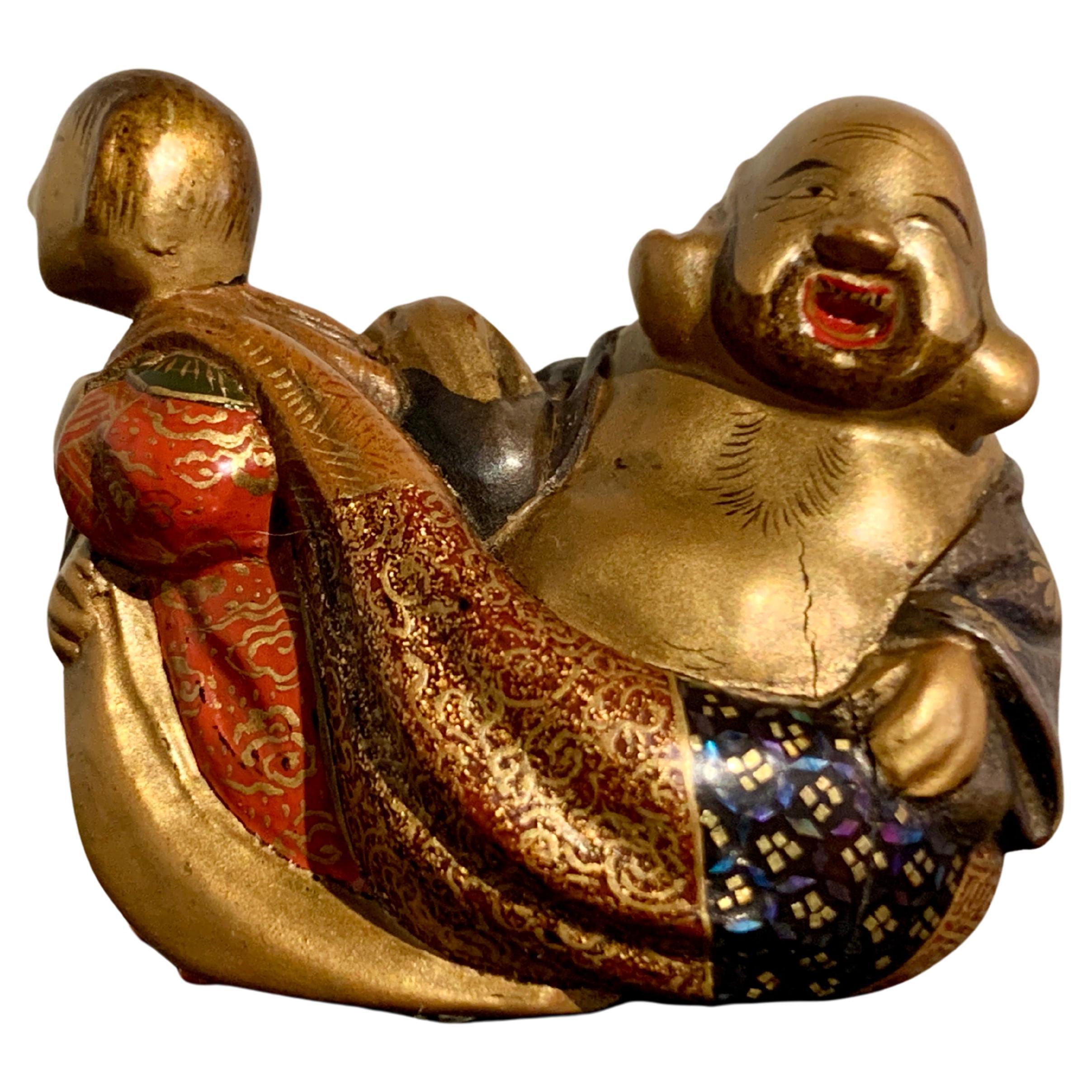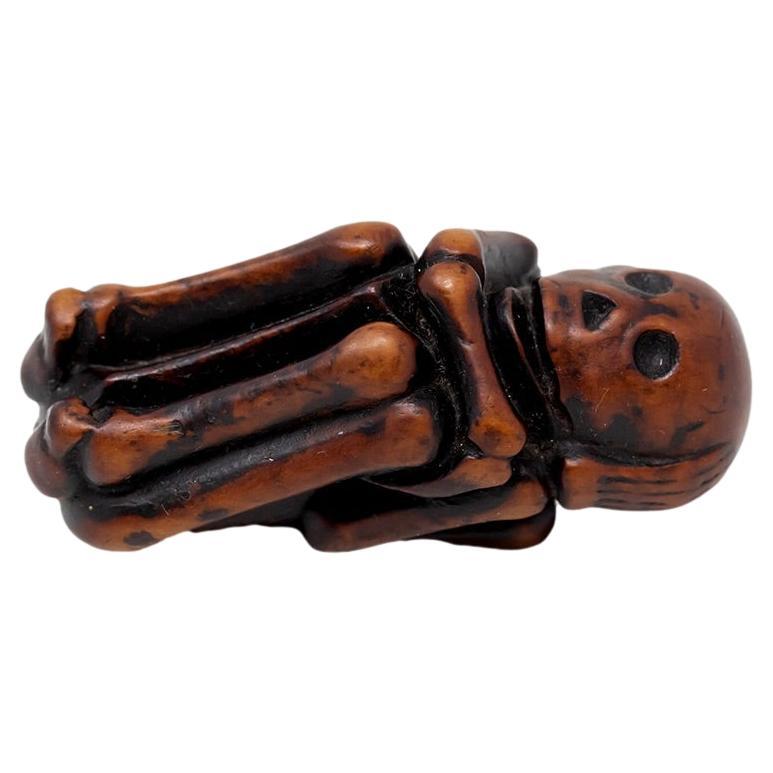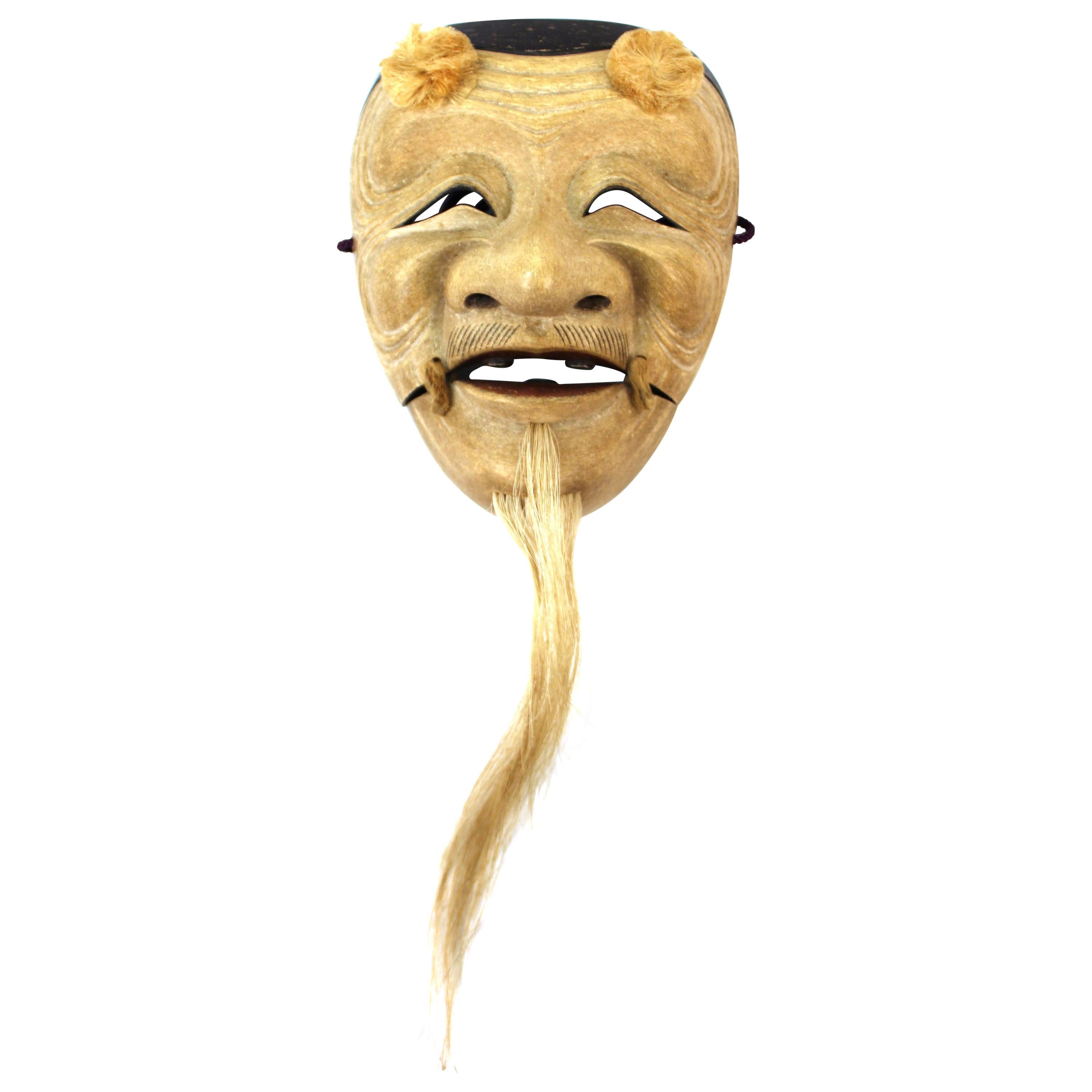Items Similar to Carved Boxwood and Lacquer Netsuke of a Noh Dancer, Meiji Period, Japan
Want more images or videos?
Request additional images or videos from the seller
1 of 12
Carved Boxwood and Lacquer Netsuke of a Noh Dancer, Meiji Period, Japan
About the Item
A fine lacquer decorated carved boxwood netsuke of a Noh dancer in a Hannya role, unsigned, Meiji period, late 19th century, Japan.
The boxwood netsuke finely carved as a kneeling Noh dancer dressed in striking geometric patterned robes. The actor holds an opened war fan behind their back in one hand, a Shinto wand slung over the shoulder in the other.
The war fan, tessen, decorated in red lacquer with a golden rising sun at the center. Tessen were sturdy fans used by samurai as protective devices, and sometimes as weapons.
The wand, called an onusa, is a traditional Shinto ritual implement comprised of folded paper streamers, shide, attached to a wooden wand, often used in purification rituals. Here, the shide are crafted from silver maki-e, with the handle of the natural boxwood.
The actor wears a fierce and unearthly hannya mask, the grotesque face fixed with a predatory smile. A mane of long hair frames the face and extends down the back.
Hannya characters in Noh dramas portray scorned women consumed by jealousy and anger, transforming them into demons.
Netsuke are small Japanese sculptures originally used to secure sagemono and inro, traditional carrying pouches and cases, to belts or sashes.
- Dimensions:Height: 1.88 in (4.78 cm)Width: 1 in (2.54 cm)Depth: 1.13 in (2.88 cm)
- Style:Meiji (Of the Period)
- Materials and Techniques:
- Place of Origin:
- Period:
- Date of Manufacture:circa 1890
- Condition:Wear consistent with age and use. Minor fading. In very good condition. No cracks, chips or repairs noted. Minor wear to the gilt lacquer. The silver maki-e tarnished.
- Seller Location:Austin, TX
- Reference Number:1stDibs: LU894731119222
About the Seller
5.0
Platinum Seller
These expertly vetted sellers are 1stDibs' most experienced sellers and are rated highest by our customers.
Established in 2001
1stDibs seller since 2010
306 sales on 1stDibs
Typical response time: 1 hour
- ShippingRetrieving quote...Ships From: Austin, TX
- Return PolicyA return for this item may be initiated within 7 days of delivery.
More From This SellerView All
- Boxwood and Lacquer Netsuke of Hotei by Shunsho, Meiji period, circa 1900, JapanLocated in Austin, TXA charming and finely decorated carved and lacquered boxwood netsuke of Hotei by Shunsho (probably Shunsho XI, Masaoki), Meiji period, circa 1900, Japan. This delightful and colorful netsuke features the beloved figure Hotei, one of the Seven Lucky Gods. The god of fortune and happiness is seated upon his treasure bag, and being dragged by a smiling child. Carved from boxwood and decorated in bright lacquers of gold, silver, red, black and green. Hotei's chest and ample stomach mostly exposed, his skin covered in gold lacquer. Large elephantine ears frame his bearded face. His red-lipped mouth open in an uproarious laugh. Hotei's treasure bag formed as a patchwork of various brocades in gold, red, and black lacquer. The black lacquer further decorated in the lac burgaute...Category
Antique Early 1900s Japanese Meiji Sculptures and Carvings
MaterialsBoxwood, Lacquer
- Japanese Tokyo School Bronze Okimono of a Farmer, Meiji PeriodLocated in Austin, TXA very fine and detailed Tokyo School cast bronze okimono (decorative sculpture) of a smiling farmer, Meiji period, late 19th century, Japan. The e...Category
Antique Late 19th Century Japanese Meiji Sculptures and Carvings
MaterialsBronze
- Japanese Gilt Wood Fukukenjaku Kannon, Meiji Period or Earlier, JapanLocated in Austin, TXAn attractive and esoteric Japanese carved and gilt wood figure of Fukukenjaku Kannon, Amoghapasa, Meiji period or earlier, Japan. Fukukenjaku Kannon is portrayed in an usual six...Category
Antique Early 1900s Japanese Meiji Sculptures and Carvings
MaterialsCypress
- Japanese Miyao Style Gilt Bronze Samurai Archer, Meiji Period, JapanBy Eisuke Miyao 1Located in Austin, TXA spectacular Japanese cast, carved, and parcel gilt bronze sculpture, okimono, of a kneeling samurai archer, signed Kiyotsugu (died 1894), Meiji ...Category
Antique Late 19th Century Japanese Meiji Sculptures and Carvings
MaterialsBronze
- Pair of Japanese Gilt Bronze Komainu by Ishikawa Komei, Meiji PeriodLocated in Austin, TXA striking pair of Japanese gilt bronze komainu by the renowned Japanese sculptor, Ishikawa Komei (1852-1913), Meiji period, Japan. The pair well cast, and robustly modeled. They ar...Category
Antique Late 19th Century Japanese Meiji Sculptures and Carvings
MaterialsBronze
- Japanese Carved and Lacquered Wood Shogun, Edo Period, 19th Century, JapanLocated in Austin, TXAn unusual Japanese carved wood, lacquer, and gilt decorated portrait sculpture of a shogun, Edo Period, early 19th century, Japan. The unidentified shogun (possibly Tokugawa Iey...Category
Antique Mid-19th Century Japanese Edo Sculptures and Carvings
MaterialsWood, Lacquer
You May Also Like
- Japanese Meiji Noh Mask in Carved WoodLocated in New York, NYJapanese early Meiji period Noh theater mask made of carved wood with gofun layers. The piece was made in Japan in circa 1880 and is signed on the back. In great antique condition wi...Category
Antique 1880s Japanese Meiji Sculptures and Carvings
MaterialsWood
- Japanese Skeleton Boxwood Netsuke Late Edo PeriodLocated in Newark, EnglandJapanese boxwood netsuke depicting a skeleton. The skeleton naturalistically carved in the foetal position in preparation for transitional burial. With...Category
Antique Mid-19th Century Japanese Edo Sculptures and Carvings
MaterialsWood, Boxwood
- Japanese Meiji Noh Mask of OkinaLocated in New York, NYJapanese carved wood Noh mask depicting Okina. The piece was made during the late Edo - early Meiji period in the 19th century. The mask is of an older man wi...Category
Antique 19th Century Japanese Meiji Sculptures and Carvings
MaterialsWood
- Japanese Meiji era chestnut netsukeLocated in PARIS, FRWooden netsuke featuring a group of three chestnuts. One of them reveals a tiny hole and the head of a small worm in bone inlay, offering a very naturalistic representation. Chestnu...Category
Antique Late 19th Century Japanese Japonisme Sculptures and Carvings
MaterialsBoxwood
- Meiji Period Carved Lion and TigerLocated in Pasadena, CAThis is an outstanding pair of Meiji Period carved hardwood figures of a ferocious lion and tiger. The carving is exceptional as is the bone detailing of the mouthes and teeth. The f...Category
Antique Late 19th Century Japanese Meiji Animal Sculptures
MaterialsBone, Hardwood
- Japan 1890 Meiji Period Rare Carved Okimono Of A Father And Son Playing SignedLocated in Miami, FLJapanese Okimono sculpture of a father and son. Very rare and highly detailed sculpture, created during the meiji period (1868-1912) in the imperial Japan, circa 1890. This sculptural Okimono is very well realized and exceptionally proportionate. Show the figures of a father and a son playing, with happiness and smiling. The father hold a big basket at his back and both personages are wearing kimonos richly engraved. This piece was made from a carving with exceptional craftsmanship and intricate details. This sculpture stand itself on his own base and have all retain of the applied ochre ink accents. Measures: 130 mm by 45 mm by 53.3 mm (5.1 x 1.75 x 2.1 inches). Weight: 81.30 grams. Note: This kind of family scene is very rare to seen in nineteenth century japanese iconography. Okimono Is a Japanese term meaning for display an ornament; art object; or decorative object, usually displayed in a tokonoma or butsudan "Buddhist altar". It is an ornament or figure, especially one placed in a guest room. An okimono may be a small Japanese carving, similar to but larger than a netsuke. Unlike the netsuke, which had a specific purpose, the okimono is exclusively decorative and was displayed in the tokonoma. During the Meiji period, many okimonos were made for export to the West. Meiji Period This is an era of Japanese history that extended from October 23, 1868 to July 30, 1912.The Meiji era was the first half of the Empire of Japan, when the Japanese people moved from being an isolated feudal society at risk of colonization by Western powers to the new paradigm of a modern, industrialized nation state and emergent great power, influenced by Western scientific, technological, philosophical, political, legal, and aesthetic ideas. As a result of such wholesale adoption of radically different ideas, the changes to Japan were profound, and affected its social structure, internal politics, economy, military, and foreign relations...Category
Antique 1890s Japanese Meiji Sculptures and Carvings
MaterialsWood, Paint
Recently Viewed
View AllMore Ways To Browse
Antique Boxwood
Hand Carved War
Antique Hand Fan Hand Fans
Antique Fan Hand
Antique Fans Hand Fans
Antique Hand Fans
Antique Hand Fan
Hand Fan Antique
Japanese Hair
Wooden Sculpture Japanese
Wears A Mask
Asian War
Red Lacquer Sculpture
Japanese Silver Sculpture
Japanese Wooden Carved
Japanese Hand Carved Wooden
Japanese Fan Art
Japanese Meiji Carving





